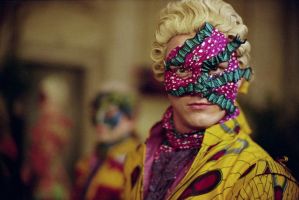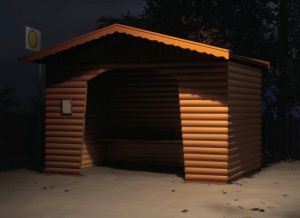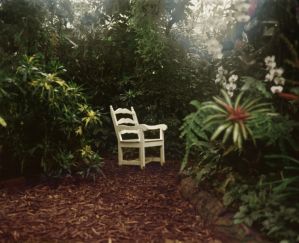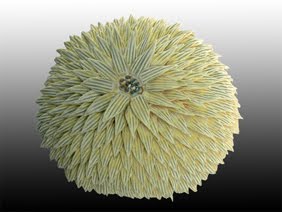theartsdesk in Monte Carlo: Nouveau Musée Nationale de Monaco | reviews, news & interviews
theartsdesk in Monte Carlo: Nouveau Musée Nationale de Monaco
theartsdesk in Monte Carlo: Nouveau Musée Nationale de Monaco
A new cutting-edge museum may provide a culture shock for the land of bling
Famous for its fast cars, casino, and stashing away Sir Philip Green’s gazillions, the principality of Monaco certainly isn’t a destination short on bling, nor a sense of faded, somewhat seedy glamour. So it probably isn’t high on anyone’s list for culture, least of all for contemporary art. But things are definitely on the turn: a new museum offering a genuinely challenging programme of international contemporary art has recently opened.
Nouveau Musée Nationale de Monaco (NMNM) is housed in two elegant Belle Époque villas: Villa Sauber, currently showing an exhibition of work by British-Nigerian artist Yinka Shonibare, and Villa Paloma, which opened last week with a group show curated by German photographer Thomas Demand. The director of the museum is Marie-Claude Beaud, former director of Fondation Cartier pour l’Art Contemporain. She is keen not only to educate a public who may be slightly wary of difficult contemporary art, but also to establish the museum as a serious venue that attracts the attention of the cognoscenti. Its chief curator, Cristiano Raimondi, certainly appreciates that for Monte Carlo, the work may even be considered “a little bit dangerous”.
 That said, Shonibare will probably be quite a friendly introduction to contemporary art for the museum’s visitors. The one-time Turner Prize nominee is best known for his use of colourful batik fabric, which although considered African was originally manufactured in Indonesia and bought to Africa by 19th-century Dutch colonisers (Shonibare now buys it in bulk in Brixton Market, in south-west London). Here he shows a selection of apparently 18th-century costumes made in the highly patterned fabric and displayed among the museum’s permanent collection of exquisite theatre maquettes and costumes. A short film by him shows dancers in elaborate dress so brightly coloured that it looks as if they’re at an 18th-century psychedelic masque (pictured above right). But they are dancing to the sound of silence, so all you can hear is the frantic but nifty footwork.
That said, Shonibare will probably be quite a friendly introduction to contemporary art for the museum’s visitors. The one-time Turner Prize nominee is best known for his use of colourful batik fabric, which although considered African was originally manufactured in Indonesia and bought to Africa by 19th-century Dutch colonisers (Shonibare now buys it in bulk in Brixton Market, in south-west London). Here he shows a selection of apparently 18th-century costumes made in the highly patterned fabric and displayed among the museum’s permanent collection of exquisite theatre maquettes and costumes. A short film by him shows dancers in elaborate dress so brightly coloured that it looks as if they’re at an 18th-century psychedelic masque (pictured above right). But they are dancing to the sound of silence, so all you can hear is the frantic but nifty footwork.
Monte Carlo has had a long association with dance, so Shonibare’s work seems actually quite at home. It is also visually sumptuous, so it isn't completely outdone by the museum’s historical collection, while his photographic series Diary of a Victorian Dandy, in which Shonibare himself is incongruously depicted as the dissolute dandy, makes an apt comment – considering its context – on excess, wealth and power.
 NMNM’s second home, the Villa Paloma, looks down towards the harbour and is surrounded by luscious gardens. But inside the multi-floor gallery all is austere, a suitable setting for the work of coolly conceptual photographer Thomas Demand. He is showing his large-scale prints alongside a number of artists both living and dead. These include Belgian Surrealist René Magritte, from whom the exhibition’s title La Carte d'après Nature takes its name, and contemporary British artists Rodney Graham and Tacita Dean.
NMNM’s second home, the Villa Paloma, looks down towards the harbour and is surrounded by luscious gardens. But inside the multi-floor gallery all is austere, a suitable setting for the work of coolly conceptual photographer Thomas Demand. He is showing his large-scale prints alongside a number of artists both living and dead. These include Belgian Surrealist René Magritte, from whom the exhibition’s title La Carte d'après Nature takes its name, and contemporary British artists Rodney Graham and Tacita Dean.
Demand himself meticulously constructs objects and settings from cardboard and paper (pictured above left: Haltestelle, 2009), so that at first you may not realise that the scene is entirely artificial. The work presents an interesting dialogue in a show whose theme focuses on representations of the natural world and which often veers towards the fantastical and mildly sinister.
 It also turns up a wonderful discovery, for me at least: the work of the Italian photographer Luigi Ghirri, whose photographs, from the late Sixties and Seventies, frame the world in such a way that it appears distinctly odd and other-worldly: a chair that has simply been left in the middle of an overgrown garden lit by a slightly surreal glow that makes you wonder what could have taken place there (pictured above right); gentlemen’s hats perched on stands in the window of a hat shop, but with the photograph taken from the interior looking out, rather than from the street looking in. Like the slow films of Dean (main picture: Prisoner Pair, 2008), which explore, in a very simple and direct way, texture and shape and light, these images insist on taking a fresh view of things.
It also turns up a wonderful discovery, for me at least: the work of the Italian photographer Luigi Ghirri, whose photographs, from the late Sixties and Seventies, frame the world in such a way that it appears distinctly odd and other-worldly: a chair that has simply been left in the middle of an overgrown garden lit by a slightly surreal glow that makes you wonder what could have taken place there (pictured above right); gentlemen’s hats perched on stands in the window of a hat shop, but with the photograph taken from the interior looking out, rather than from the street looking in. Like the slow films of Dean (main picture: Prisoner Pair, 2008), which explore, in a very simple and direct way, texture and shape and light, these images insist on taking a fresh view of things.
 Another welcome discovery is the ceramic sculpture of American artist Chris Garofalo, which presents an array of strange hybrids of living biological forms (pictured left). Given scientific-sounding names, they look - with their spiny tentacles and sucker-like shiny surfaces - like plausible representations of marine life.
Another welcome discovery is the ceramic sculpture of American artist Chris Garofalo, which presents an array of strange hybrids of living biological forms (pictured left). Given scientific-sounding names, they look - with their spiny tentacles and sucker-like shiny surfaces - like plausible representations of marine life.
This takes us rather neatly on a final stop, to the Musée Océanographic de Monaco, in which - amid the bones and the stuffed bodies of actual marine life - we find artistically crafted hybrids of sea creatures, such as the fish with a monkey’s head made in 19th-century Japan. The museum provides the rather opulent setting for an exhibition of the work of Damien Hirst, whose sharks in formaldehyde – there are two in the exhibition – sit rather well with the museum’s permanent scientific collection. There are examples also of his butterfly paintings, his spin paintings and his dot paintings – with two incredibly tall dot paintings fitting perfectly on to the walls of the museum’s grand foyer.
There are also four of Hirst’s gold-framed glass cabinets filled with rows of different-coloured semi-precious stones, all glinting against a mirrored backdrop. One is once again back in the territory of bling – so perhaps not quite a culture shock for Monte Carlo, after all.
- La Carte D'Après Nature at Nouveau Musée Nationale de Monaco until 22 February 2011
- Yinka Shonibare: Looking Up at Nouveau Musée Nationale de Monaco until 16 January 2011
- Damien Hirst: Cornucopia at the Musée Océanographique de Monaco until 30 September
more Visual arts
 Yinka Shonibare: Suspended States, Serpentine Gallery review - pure delight
Weighty subject matter treated with the lightest of touch
Yinka Shonibare: Suspended States, Serpentine Gallery review - pure delight
Weighty subject matter treated with the lightest of touch
 Jane Harris: Ellipse, Frac Nouvelle-Aquitaine MÉCA, Bordeaux review - ovals to the fore
Persistence and conviction in the works of the late English painter
Jane Harris: Ellipse, Frac Nouvelle-Aquitaine MÉCA, Bordeaux review - ovals to the fore
Persistence and conviction in the works of the late English painter
 Sargent and Fashion, Tate Britain review - portraiture as a performance
London’s elite posing dressed up to the nines
Sargent and Fashion, Tate Britain review - portraiture as a performance
London’s elite posing dressed up to the nines
 Zineb Sedira: Dreams Have No Titles, Whitechapel Gallery review - a disorientating mix of fact and fiction
An exhibition that begs the question 'What and where is home?'
Zineb Sedira: Dreams Have No Titles, Whitechapel Gallery review - a disorientating mix of fact and fiction
An exhibition that begs the question 'What and where is home?'
 Yoko Ono: Music of the Mind, Tate Modern review - a fitting celebration of the early years
Acknowledgement as a major avant garde artist comes at 90
Yoko Ono: Music of the Mind, Tate Modern review - a fitting celebration of the early years
Acknowledgement as a major avant garde artist comes at 90
 Unravel: The Power and Politics of Textiles in Art, Barbican review - the fabric of dissent
An ambitious exploration of a neglected medium
Unravel: The Power and Politics of Textiles in Art, Barbican review - the fabric of dissent
An ambitious exploration of a neglected medium
 When Forms Come Alive, Hayward Gallery review - how to reduce good art to family fun
Seriously good sculptures presented as little more than playthings or jokes
When Forms Come Alive, Hayward Gallery review - how to reduce good art to family fun
Seriously good sculptures presented as little more than playthings or jokes
 Entangled Pasts 1768-now, Royal Academy review - an institution exploring its racist past
After a long, slow journey from invisibility to agency, black people finally get a look in
Entangled Pasts 1768-now, Royal Academy review - an institution exploring its racist past
After a long, slow journey from invisibility to agency, black people finally get a look in
 Barbara Kruger, Serpentine Gallery review - clever, funny and chilling installations
Exploring the lies, deceptions and hyperbole used to cajole, bully and manipulate us
Barbara Kruger, Serpentine Gallery review - clever, funny and chilling installations
Exploring the lies, deceptions and hyperbole used to cajole, bully and manipulate us
 Richard Dorment: Warhol After Warhol review - beyond criticism
A venerable art critic reflects on the darkest hearts of our aesthetic market
Richard Dorment: Warhol After Warhol review - beyond criticism
A venerable art critic reflects on the darkest hearts of our aesthetic market
 Dineo Seshee Raisibe Bopape: (ka) pheko ye / the dream to come, Kiasma, Helsinki review - psychic archaeology
The South African artist evokes the Finnish landscape in a multisensory installation
Dineo Seshee Raisibe Bopape: (ka) pheko ye / the dream to come, Kiasma, Helsinki review - psychic archaeology
The South African artist evokes the Finnish landscape in a multisensory installation
 Paul Cocksedge: Coalescence, Old Royal Naval College review - all that glitters
An installation explores the origins of a Baroque masterpiece
Paul Cocksedge: Coalescence, Old Royal Naval College review - all that glitters
An installation explores the origins of a Baroque masterpiece

Add comment